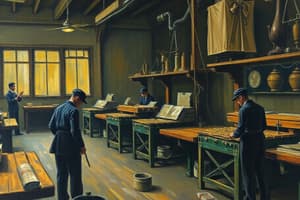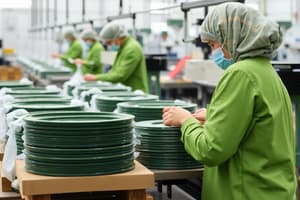Podcast
Questions and Answers
Which production method is most suitable for creating highly customized products tailored to individual consumer needs?
Which production method is most suitable for creating highly customized products tailored to individual consumer needs?
- Mass production
- Continuous flow production
- One-off production (correct)
- Batch production
A company needs to produce a limited run of a product, allowing for some variation and customization between production cycles. They also want to minimize initial capital investment. Which production method is most appropriate?
A company needs to produce a limited run of a product, allowing for some variation and customization between production cycles. They also want to minimize initial capital investment. Which production method is most appropriate?
- Batch production (correct)
- Continuous flow production
- One-off production
- Mass production
Which of the following is a primary disadvantage of mass production?
Which of the following is a primary disadvantage of mass production?
- Flexibility in adjusting to market demands
- Low employee morale and increased employee turnover (correct)
- Low initial capital investment
- High degree of customization
A small startup company wants to produce a new product but has limited capital. Which production method would allow them to start with a single production line and scale up later?
A small startup company wants to produce a new product but has limited capital. Which production method would allow them to start with a single production line and scale up later?
What is a key benefit of using a CIM (Computer Integrated Manufacturing) system in mass customization?
What is a key benefit of using a CIM (Computer Integrated Manufacturing) system in mass customization?
In which production method is the product design least likely to consider 'Design for Disassembly' (DfD)?
In which production method is the product design least likely to consider 'Design for Disassembly' (DfD)?
A bakery produces 50 loaves of white bread, followed by 50 loaves of wheat bread, and then 30 buns, using the same oven. This is an example of which production method?
A bakery produces 50 loaves of white bread, followed by 50 loaves of wheat bread, and then 30 buns, using the same oven. This is an example of which production method?
What is the primary goal of implementing differentiation, formalization, and specialization in mass production?
What is the primary goal of implementing differentiation, formalization, and specialization in mass production?
Which factor most directly contributes to the high precision rate often achieved in mass production?
Which factor most directly contributes to the high precision rate often achieved in mass production?
A company that manufactures specialized, handcrafted furniture would most likely use which production method?
A company that manufactures specialized, handcrafted furniture would most likely use which production method?
Flashcards
One-Off Production
One-Off Production
Producing a single, unique item tailored to specific needs, often using craft techniques or a combination of craft and machines.
Batch Production
Batch Production
A manufacturing method to produce or process any product in batches.
Mass Production
Mass Production
Production of large amounts of standardized products on production lines, permitting very high rates of production per worker.
Mass Customization
Mass Customization
Signup and view all the flashcards
The Goal of Mass Production
The Goal of Mass Production
Signup and view all the flashcards
Batch Production
Batch Production
Signup and view all the flashcards
Group Customizations
Group Customizations
Signup and view all the flashcards
Mass Production Workforce Traits
Mass Production Workforce Traits
Signup and view all the flashcards
Study Notes
- Production types vary based on product customization and the quantity needed.
One-Off Production
- This involves creating individual products or prototypes, often for larger-scale production later.
- It combines craft production techniques with machines.
- There is close interaction between the manufacturer and consumer to meet user needs and is highly customizable.
- Prototypes, specialist models, hand-crafted items, and specialist engineering/architecture fall under this category.
- It offers flexibility for designers and consumers.
- It allows testing of prototypes prior to continuous flow production.
- It can be expensive because tools and machinery costs are factored in the final price.
- It is time-consuming if craft manufacturing is involved.
- Products might not be designed for disassembly, lacking interchangeable parts.
Batch Production (Limited Production Run)
- This is manufacturing products in batches, which can be mechanized or automated.
- It is more cost-effective than one-off production.
- Products are customizable.
- It easily adapts to market demands or seasonal items.
- It provides more consumer choice, helping smaller or startup companies that cannot afford continuous flow production.
- It can lower initial capital because only a single production line is needed.
- Downtime exists between production runs for retooling.
- Product storage raises the cost per item.
- It is a production method where products are made in groups (batches), rather than continuously.
- Machinery is reused to make subsequent batches of goods.
- It is typically used for group orders rather than mass production.
- It is one of the three primary forms of manufacturing, along with job and flow.
- It offers flexibility by allowing customization to meet specific customer needs while maintaining higher productivity compared to a job-based system.
- Jigs and templates are used to reduce changeover time between batches; cycle time is the time between consecutive batches.
- Machinery can be reused for different batches with minor modifications (color, size, or shape).
- Customizations can occur at the group level to produce batches based on market demand.
- Smaller batches benefit from reduced time and efficient quality control.
- Its reusability and enhanced quality control make it more cost-efficient compared to continuous manufacturing.
- It lowers costs because a single production line can manufacture diverse products with slight modifications.
- Specialist machinery and skills can boost output and productivity. However, switching time between jobs and inventory can lead to inventory costs.
- Baking, meal preparation, making clothes etc are examples of where it is used.
Mass Production
- It's the production of large quantities of standardized products on production lines.
- This process needs large quantities of products and allows for high production rates per worker.
- Mass Customization uses CIM systems to tailor products to individual customer needs.
- Mass Customization uses the CIM system to manufacture products according to individual customer needs.
- Mass customization benefits from economy of scale for both single orders and large quantities.
- The relationship between the manufacturer and customer strengthens because individual requirements dominate.
- It achieves economies of scale with small orders and is highly customizable to customer needs/preferences.
- In mass production, assembly lines and automation are utilized to produce a high volume of similar products.
- It involves multiple assembly lines, where workers perform routine, specialized procedures.
- Differentiation, formalization, and specialization are used to keep manufacturing costs low by producing uniform products.
- Sophisticated technologies simplify manufacturing. The large-scale demand for mass-produced products, manufactured inexpensively with minimal workforce, is satisfied using precision machining equipment.
- High precision is possible if production is monitored and validated using established parameters.
- Mechanization reduces or eliminates redundant job roles, leading to low production costs.
- Automation allows for faster assembly of mass-produced items, boosting efficiency, competitiveness, and profitability through rapid distribution.
- Mass production is capital-intensive, requiring automated assembly lines, and large investments for setup/maintenance.
- Mass production systems require continuous upgrading and improvements to keep up with market innovations.
- There can be low employee morale and high employee turnover due to the repetitive nature of mass production.
Studying That Suits You
Use AI to generate personalized quizzes and flashcards to suit your learning preferences.




